I loved Yangon for reasons directly relating to food and affordable living, followed by its amazing sights and sounds. But what sealed my eternal love for this city were two offbeat things that did not get enough attention – like a ride on the Circular Train and a visit to the Snake Temple.
Let me explain –
The Circular Train
A train that leaves and arrives at the same station on its circular route, doesn’t make for great stories. Right? Wrong! In Yangon, this train, despite its remarkably slow speed and uncomfortable chairs is the best way to see the countryside and the life of its people at close proximity.
For two hundred Kyats (about 0.15 dollars) I boarded the Circular Train from Platform 7 at the Yangon Central Railway Station, along with a few hundred locals armed with a variety of goods for sale, including hairbrush, nail cutters and quail eggs, on an extremely delightful journey of 3.5 hours through over 39 stations. It was clearly not a Tourist -Only train, but a mode of transport for local commuters.
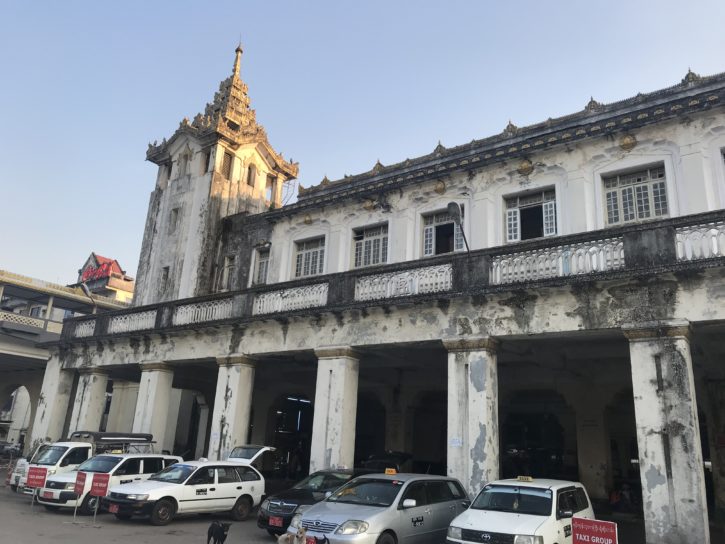
(Note: The train doesnt always leave from the same platform, so make sure you are on the right train. Tickets can be bought ONLY at the platform from which the train departs)
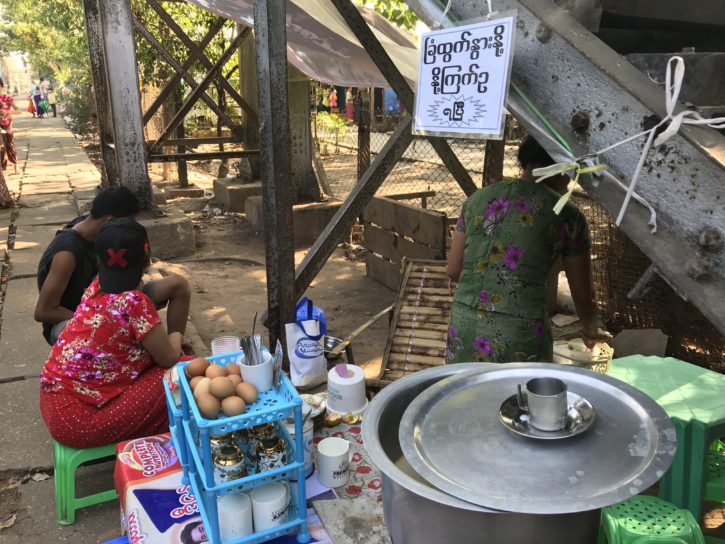
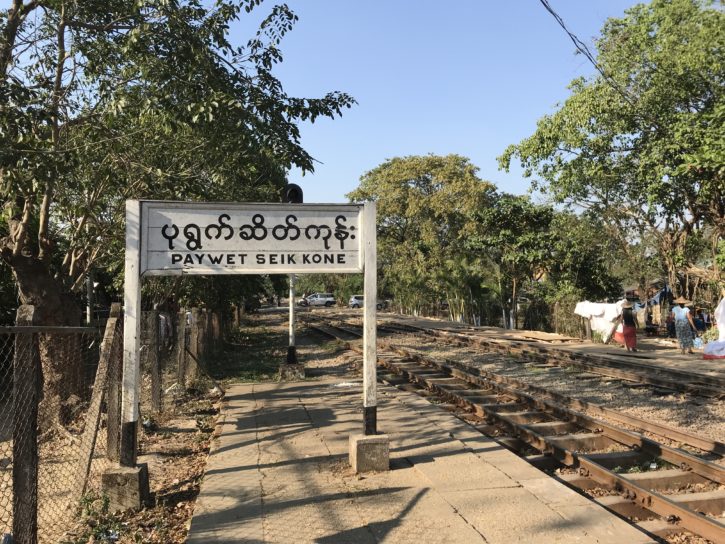
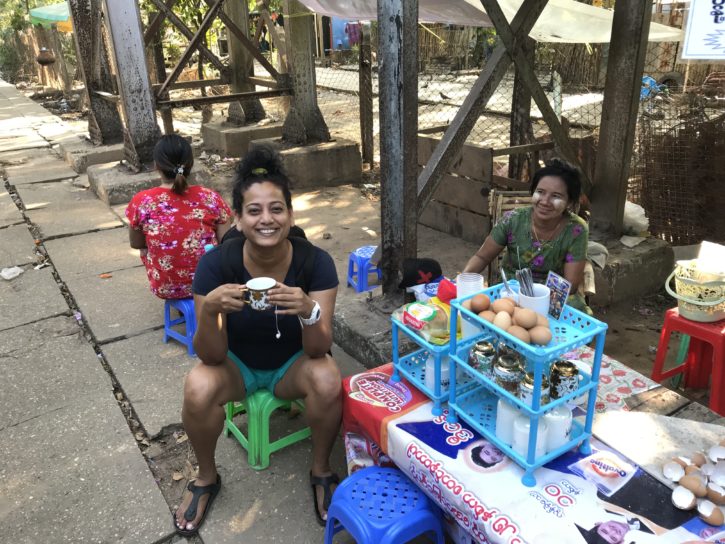
From the City Centre, the old train crawled over the squeaky tracks and wound its way past the suburbs and into the outlying rural areas, and markets. This, I found to be a very interesting way of seeing the area. The real life of Myanmar unfolds right outside the train window that doesn’t shut – with small scale food vendors calling out over the din, larger markets exploding with fruits, vegetables and clothes, people walking to work, children running along the tracks, monks collecting alms, women up to their waist in water gathering water-spinach, piles of burning rubbish and plastic-chocked ponds all went by and I happily soaked it all up.
Plastic ban is yet to be implemented and for once I wished it would be made top priority.
Check out this comprehensive 10 days itinerary for Myanmar
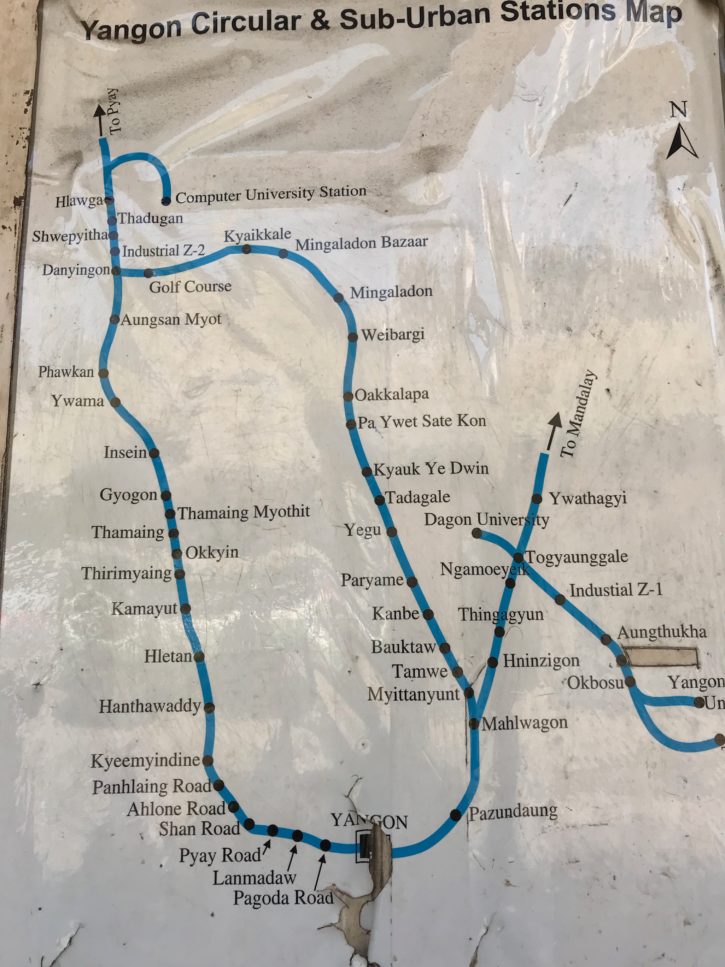
The inside of this train is just as delightful as the scenery unfolding outside. No sooner the train leaves the platform, people conduct brisk business of selling fruits, vegetables and food from their big baskets, turning the train into a mobile, open market. Fortunately for me, I never had to buy anything – because, the good people of Myanmar had no qualms about sharing their oranges or quail eggs with me.
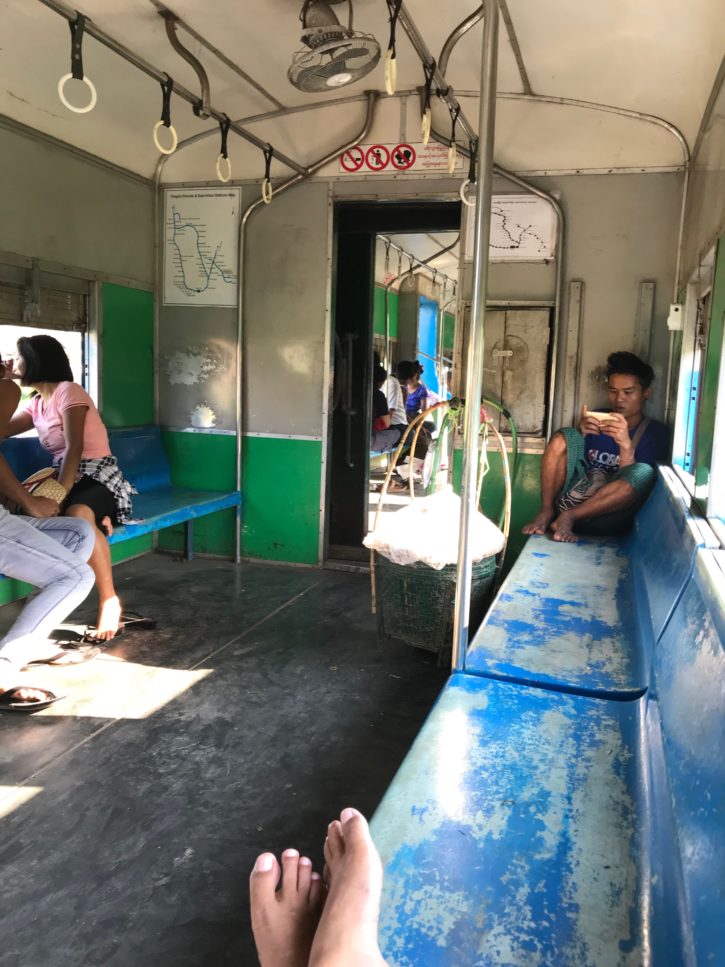
When the train stops at the station, if you are quick enough, you can bound over to the market and return with your shopping bags full. I only risked drinking a cup of thick milk at one station and bounded back with a milk mustache that the locals found interesting!
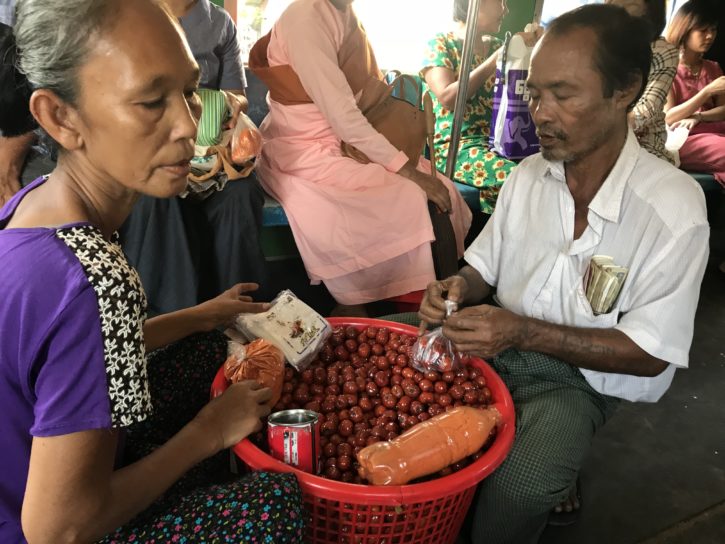
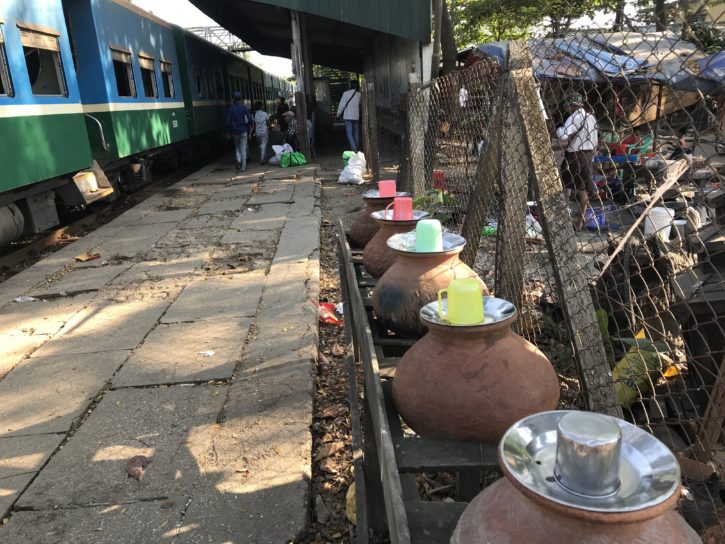
Seeing Yangon by circular train was an experience that I will value all my life because it has taught me an important lesson: poverty and kindness go hand in hand in Myanmar. The Burmese people are the kindest, most welcoming people I’ve met in my journey around Southeast Asia. They’ve made my stay in Myanmar unforgettable.
If I ever return to Yangon (to enjoy its street food), I will definitely take the journey again. Not for the landscape or the cheap ticket, but for the kinship I felt with those strangers who showed me glimpse of their lives through their warm-heartedness.
About Circular Train : The Yangon circle line train was built by the British during the colonial times and it was opened in 1954. The train operates on a 45.9 kilometers long loop and it stops at 39 stations. This means, the train stops almost every kilometer, making it very convenient for local people to get around the city. Timetable for the train may not always be accurate, so best begin your journey at the main station (built in 1877).
The Snake Temple of Yangon
I’ll start with a warning. If you suffer from ophidiophobia, stop reading right now. Because this experience, as the name suggests, is about snakes. Not the slithery or venomous ones you find in gardens, but of giant- sized, milk-fed, lazy pythons that live inside a temple on a lake.
But first, to arrive here, I had to cross the Yangon River on a ferry (tourists must buy a return ticket for 4000 Kyat) to Dala Village and engage a bike taxi to drive me to Twante, the home of Baung Daw Gyoke Pagoda (nicknamed Hmwe Paya) meaning Snake Temple. The bike-taxi driver handed me a helmet and pointed his motor West and gave it all he had.
Soon we were riding past a clock tower, paddy fields, barren lands, landfills and the ever-present golden pagodas to arrive at the oddest things I have seen in all my travels. A snake temple sitting calmly in the centre of a lake filled with fat fishes lovingly fed puff-rice and bread by pilgrims and tourists.
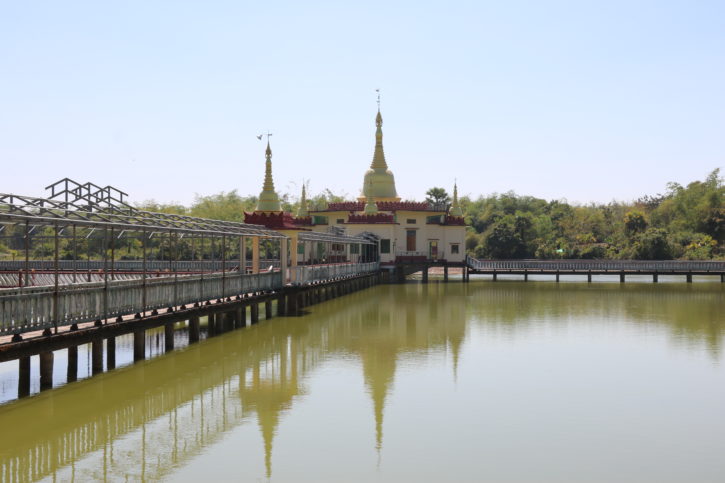
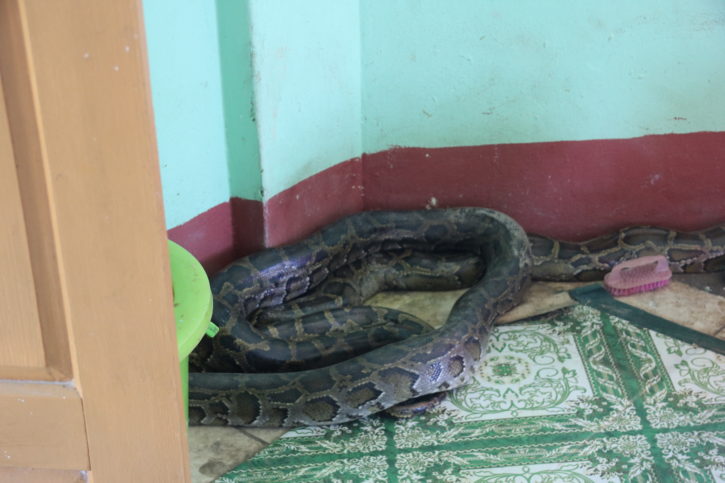
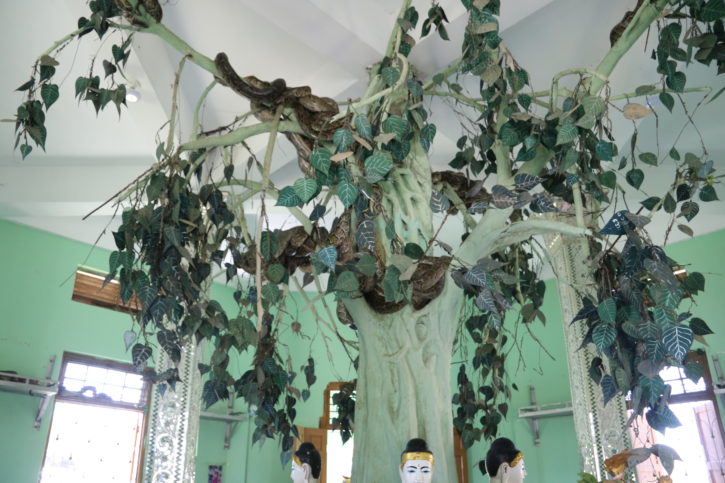
I took off my footwear as directed and accompanied a bunch of kids trying to sell me fish food and walked barefoot across the elevated wooden platform, thinking of what I would find.
The sight that greeted me was this -– A concrete Bodhi tree with green branches with three Buddha figurines around it and about thirty, long, fat and lazy Burmese pythons moving slowly through the branches above, resting on window sills, curled around the figurines, or crawling across the floor, their forked tongues darting in and out as they gaze at the worshippers and me, the newest arrival.
The pythons here range from babies to old ones, they have no venom or enemies, they drink milk and eat eggs, but nothing could force me to get closer to them for a picture or a cuddle! My constant worry was that one of those reptiles would fall on me or that I would trip over those that slithered across the floor looking for corners to curl up.
Around me, many worshippers prostrated themselves in front of these pythons slinking across the temple’s floors or draped across windows. It is believed that their prayers would be granted if they prayed only for one thing – not many things. Greed is not encouraged here!
Some of the resident pythons measure up to three meters in length and are a sign of the temple’s power and auspiciousness.
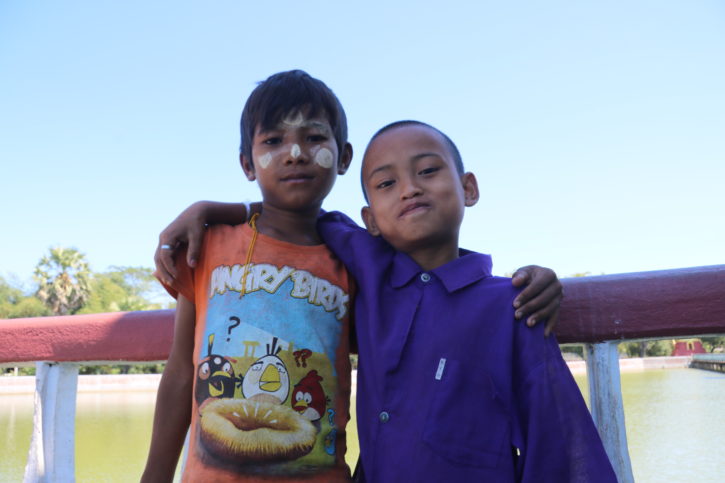 While it is common to see the image of Naga carved out of stone at temples around South East Asia, seeing a live snake at your feet or curled around Buddha statues or an unmindful monk is rare (and hair raising).
While it is common to see the image of Naga carved out of stone at temples around South East Asia, seeing a live snake at your feet or curled around Buddha statues or an unmindful monk is rare (and hair raising).
I was glad to be back on terra firma and feed fish from the safety of the banks.
Did you know?
The bodies of Burmese pythons are believed to serve as a link between the spirit world and the mundane world. They are important participants in social interactions that take place in Snake Temples all over Myanmar.
FACT BOX
- Apply for Myanmar e-visa before flying into Yangon
- Negotiate fare before you get into a taxi
- Local currency is Kyat. Always carry small change
- Yangon is a walkable city and you can easily walk to the Railway Station from the city centre.
- Local transport is cheap and efficient
- Taxis are available
- Chewing betel is very common, do not be alarmed by the red patches everywhere
- Food is generally fresh, plenty of meats and vegetarian options available
- Indian restaurants are in plenty
- Stay hydrated. Myanmar tends to get hot

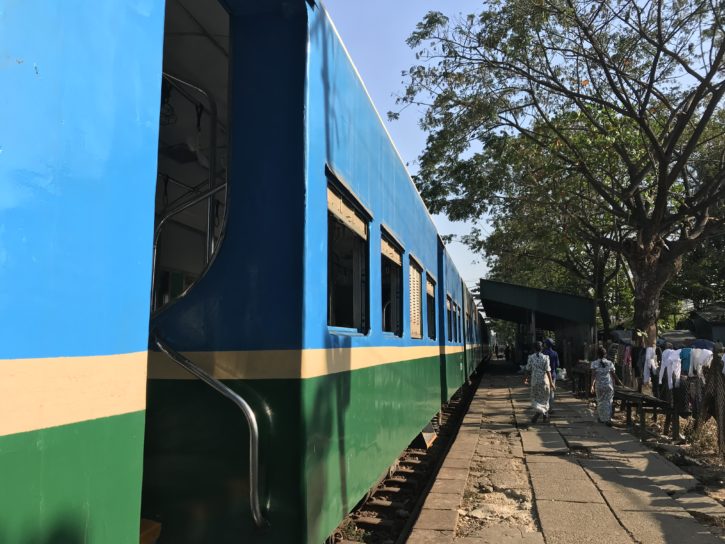

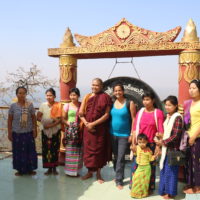



Loved reading this. Novelty train are so fun and I’d love to try this one day!
You are definitely going to love it – the best of seeing the real life of the country! I wish I could do this loop all over again.
Looks very interesting! Very unique!
It is! I recommend this ride for every traveler in Myanmar!
This is the way travel stories must be written. I was right there in the train with you. A milk moustache is an attention winner anywhere. I love snakes, especially fat lazy pythons.